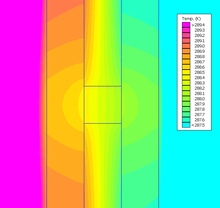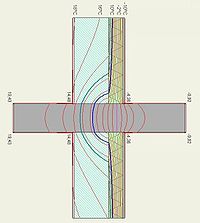- Thermal bridge
-
A thermal bridge, also called a cold bridge,[1] is a fundamental of heat transfer where a penetration of the insulation layer by a highly conductive or noninsulating material takes place in the separation between the interior (or conditioned space) and exterior environments of a building assembly (also known as the building enclosure, building envelope, or thermal envelope).[2]
Thermal bridging is created when materials that are poor thermal insulators come into contact, allowing heat to flow through the path of least thermal resistance (R-value or a materials effectiveness in resisting the conduction of heat) created, although nearby layers of material separated by airspace allow little heat transfer.[3]
Insulation around a bridge is of little help in preventing heat loss or gain due to thermal bridging; the bridging has to be eliminated, rebuilt with a reduced cross-section or with materials that have better insulating properties, or with a section of material with low thermal conductivity installed between metal components to retard the passage of heat through a wall or window assembly, called a thermal break.
Contents
Concept
Several properties of materials affect heat transfer. Examples include thermal conductivities, specific heats, material densities, fluid velocities, fluid viscosities, and surface reflectance and emittance characteristics. Thermal bridges are characterized by multi-dimensional heat transfer, and therefore they cannot be adequately approximated by the one-dimensional models of calculation typically used in norms and standards for the thermal performance of buildings (U-values). Surface moisture due to condensation, typically occurring in such regions as floor-wall connections and window installations, as well as mold growth in humid environments can also be effectively prevented by means of multi-dimensional evaluation during planning and detail design.
- Concrete balconies that extend the floor slab through the building envelope[4] are a common example of thermal bridging.
- In commercial construction, steel or concrete members incorporated in exterior wall or roof construction often form thermal bridges. [2]
- Metal ties in cavity walls are another type of thermal bridge commonly found in masonry construction. [2]
Thermal Bridging in Construction
Classification:
- Repeating thermal bridges - where bridges occur following a regular pattern, such that made by wall ties penetrating a cavity wall
- Non-repeating thermal bridges - such as the bridging of a cavity wall by a single lintel
- Geometrical thermal bridges - placed at the junction of two planes, such as at the corner of a wall
Thermal bridge concept and interior insulation
Interior insulation is used for preventing heat as well as cold from escaping or entering the building envelope, individual rooms, as well as pipes and various appliances. Heat loss of a building is prevented primarily by exterior insulation in the walls because they cover the most surface area of any building. There are many different types of materials which can be used for insulation with different characteristics. The different spaces for insulation in a building define different uses for it. [2]
Insulation requirements relating to thermal bridging
There are many different materials that are used for insulation, and new ones are often being created as the need for energy efficiency, sustainable design, and cheaper costs are currently what are driving new innovation. Currently, the types of insulation that are being used are:
- Fiberglass or rock wool insulation,
- Insulating glass or polystyrene rigid board insulation, formed in place polyurethane insulation,
- Cellulose/perlite/vermiculite loose fill, and insulated pre-cast concrete insulation.
Each type of insulating material is used most effectively in various parts of buildings including interior walls, exterior envelopes, flooring, roofing, and basements. All insulating materials have a specific R-value, which determines their thermal resistance. A good insulating material resists the conduction of heat. The higher the thermal resistance of a part of the building envelope is, the slower the heat loss. The larger the difference between the temperature inside and outside the building, the faster the building gains or losses heat. Designing a building’s walls, roofs, and floors for the maximum amount of thermal resistance results in optimal body comfort and energy conservation. [3]
One-dimensional analysis
One-dimensional analysis is based on simple, steady state, flow of heat, which means that heat is driven by a temperature differences that does not fluctuate so that heat flow is always in one direction. The product (kA) of thermal conductivity (k) and cross sectional area (A) of the heat flow path can be used in evaluating heat flow.
See also
External links
- Manufactured Structural Thermal Breaks.
- www.energiakosepitheoritis.com Thermal bridges can be eliminated at the components with the new method of construction known to date materials in all types of buildings, applying innovative method disappearance of thermal bridges in building elements has invented, implemented and patented by the Mechanical Engineer and Energy Inspector, Michael Filippidis .
- EU Information Portal BUILD UP - energy solutions for better buildings: Community 'Thermal bridge forum'
- EU IEE SAVE Project ASIEPI: topic 'Thermal bridges' - An effective handling of thermal bridges in the EPBD context
- Passivhaus Institute: Thermal Bridges in construction - how to avoid them
- Analysis of Thermal behavior of Building Constructions with Thermal Heat Bridges
- A bridge too far - ASHRAE Journal article on thermal bridging
- Basics and Some Theory of AnTherm
- Theoretical background
- University of California, 2008: Center for the Built Environment. Advanced Human Thermal Comfort Model
- International Building Code, 2009: Interior Environment
- Building Energy Codes Resource Center, 2009: What is the Building Envelope?
- TitanWall Blog, 2010: Thermal Performance of Building Envelopes
- Passive House BKLYN, 2010: Energy Revolution in a Brooklyn Townhome – Building Envelope
References
- Notes
- ^ viking-house.co.uk Cold Bridge-Thermal Bridge
- ^ a b c d [Allen, E, & Iano, J. (2009). Fundamentals of Building Construction: materials and methods. Hoboken, NJ: John Wiley & Sons Inc.] Fundamentals of Building Construction
- ^ a b [Binggeli, C. (2010). Building Systems for Interior Designers. 2nd. Hoboken, NJ: John Wiley & Sons, Inc.] Building Systems for Interior Designers
- ^ Why there are so few green buildings Heavy advertising site!
Categories:- Engineering stubs
- Insulators
- Thermal protection
- Building engineering
- Building defects
- Low-energy building
Wikimedia Foundation. 2010.


